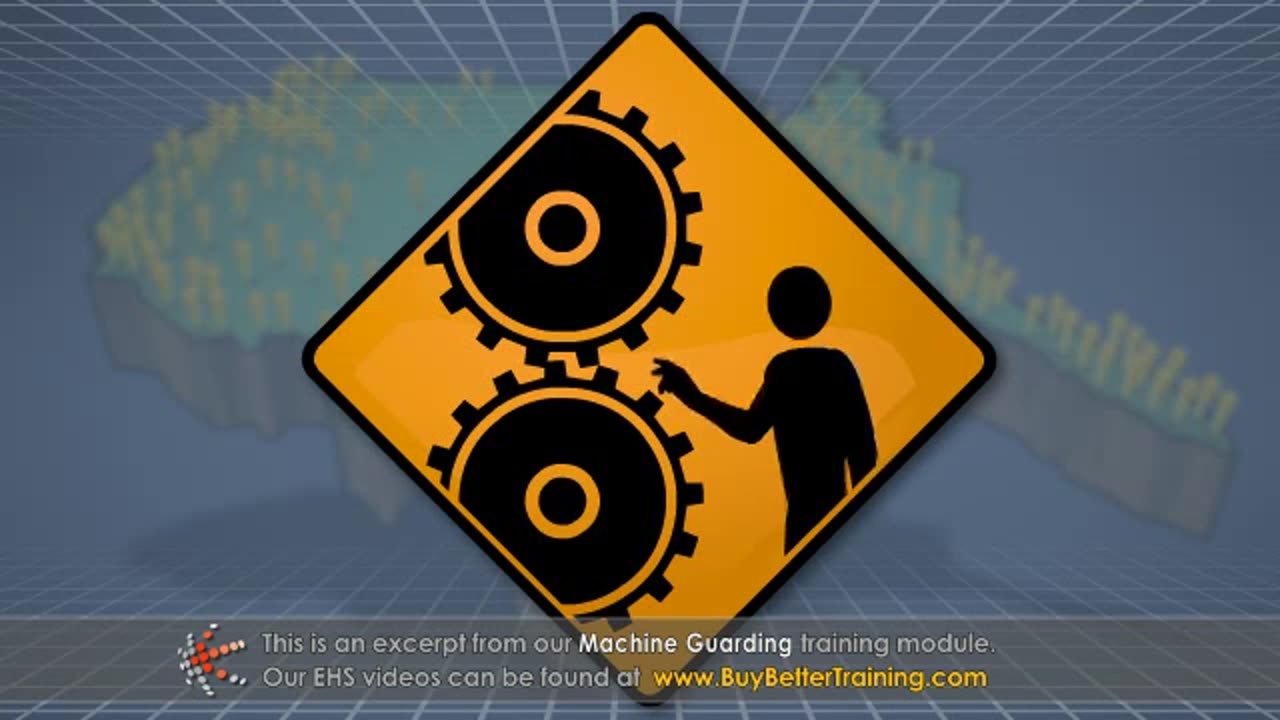Premium Only Content

Machine Guarding Training
**Machine Guarding Training** is a critical component of workplace safety, aimed at educating employees about the proper safety measures to take when operating or working near machinery. Proper machine guarding is essential to prevent injuries caused by moving parts, such as being struck by, caught in, or caught between machinery components. This training helps employees recognize hazards, understand the role of machine guards, and ensure compliance with safety standards.
### **Machine Guarding Training Outline**
#### 1. **Introduction to Machine Guarding**
- **What is Machine Guarding?**
- Definition: Machine guarding refers to the physical barriers or protective devices used to prevent accidental contact with moving machine parts, such as blades, gears, or rotating shafts.
- Importance: Prevents injuries like amputations, burns, fractures, and even fatalities by keeping employees away from dangerous areas.
- **Common Types of Machines Requiring Guarding:**
- **Power presses, saws, drills, conveyors, lathes, grinders, and other machinery** in industrial settings.
- Machines in manufacturing, construction, and agriculture that involve moving parts with potential for causing harm.
#### 2. **Understanding the Hazards**
- **Types of Hazards:**
- **Point of Operation:** The area where work is performed on the material, such as cutting, shaping, grinding, or drilling.
- **In-running Nip Points:** Areas where machine parts, like rollers, come together, posing a risk of pinching or entanglement.
- **Rotating Parts:** Shafts, pulleys, and gears that can catch clothing or body parts.
- **Flying Debris:** Small pieces of material that may be ejected from the machine during operation, such as metal shavings or sparks.
- **Electrical and Hydraulic Hazards:** Machines with electrical components or hydraulic systems may pose shock, burn, or other hazards.
- **Potential Injuries:**
- Amputations, cuts, abrasions, fractures, burns, and even fatalities caused by accidental contact with machine components.
#### 3. **Types of Machine Guards**
- **Fixed Guards:**
- **Description:** Permanent barriers or enclosures that prevent access to dangerous machine parts. Commonly used for stationary machines with fixed hazards.
- **Examples:** Enclosures around saw blades, covers over moving gears or belts.
- **Interlocking Guards:**
- **Description:** Guards that automatically shut off or prevent machine operation if they are removed or opened.
- **Examples:** Interlocked doors that stop a machine when opened.
- **Adjustable Guards:**
- **Description:** Guards that can be adjusted to accommodate different workpiece sizes or operations.
- **Examples:** Adjustable hoods over lathes or conveyors.
- **Self-Adjusting Guards:**
- **Description:** Guards that automatically adjust to the size of the workpiece, providing protection throughout the operation.
- **Examples:** Guards on saws that adjust when the operator feeds the material.
- **Presence-Sensing Devices (PSDs):**
- **Description:** Devices that detect the presence of an operator's body part within a dangerous area and automatically stop the machine.
- **Examples:** Light curtains or pressure-sensitive mats.
- **Other Protective Devices:**
- **Two-Hand Controls:** Require the operator to use both hands to engage the machine, ensuring their hands are away from the hazard.
- **Pullback Devices:** Use a system to pull back hands or arms from dangerous areas.
- **Restraint Devices:** Prevent the operator from reaching into the danger zone.
#### 4. **Machine Guarding Principles and Best Practices**
- **OSHA Standards (29 CFR 1910.212):**
- Employers must comply with OSHA regulations for machine guarding to ensure worker safety.
- Machines must be equipped with safeguards that prevent contact with hazardous parts.
- Guards should not create new hazards, such as sharp edges or pinch points.
- **General Principles for Effective Machine Guarding:**
- **Minimize Exposure:** Position guards so that the operator is kept away from moving parts.
- **Design Guards for Easy Operation:** Guards should not hinder the operator’s ability to perform their job.
- **Durability:** Guards should be made of sturdy materials that will not break or wear out easily during machine operation.
- **Clear Visibility:** Guards should allow the operator to monitor the machine without compromising safety.
- **Easy Maintenance:** Guards should be designed for easy cleaning and maintenance without requiring complete disassembly.
#### 5. **Operating Machines Safely**
- **Before Operating a Machine:**
- **Inspection:** Ensure that all guards are in place and functioning properly.
- **Lockout/Tagout:** When performing maintenance or cleaning, follow proper lockout/tagout procedures to ensure the machine is de-energized and cannot be started accidentally.
- **During Machine Operation:**
- **Avoid Removing Guards:** Never remove or bypass safety guards while operating machinery.
- **Proper Positioning:** Stand clear of rotating or moving parts, and always keep hands, clothing, and body away from hazardous zones.
- **Safe Loading and Unloading:** Use appropriate tools or devices to load and unload materials to avoid direct contact with moving parts.
- **After Operating a Machine:**
- **Post-Operation Checks:** Ensure the machine is turned off and all safeguards are in place before leaving the area.
- **Report Issues:** If a machine guard is damaged or missing, report it immediately to a supervisor for repair.
#### 6. **Maintenance and Inspection of Machine Guards**
- **Regular Inspections:**
- Machine guards should be regularly inspected for wear, damage, or misalignment. Damaged or missing guards should be replaced immediately.
- **Routine Maintenance:**
- Ensure that guards are cleaned and maintained as part of the machine's regular servicing to ensure they remain in good working order.
- Check that interlocks and safety devices are functioning correctly.
#### 7. **Training and Employee Responsibilities**
- **Employee Training:**
- Employees should be trained on the importance of machine guarding, how to identify hazards, and how to operate machinery safely.
- Training should include instruction on recognizing properly functioning guards, knowing when to report issues, and understanding the consequences of bypassing safety features.
- **Reporting Hazards:**
- Encourage employees to report any damaged or missing guards, malfunctions, or unsafe practices immediately to supervisors or safety personnel.
- **Enforcement:**
- Employers should have a clear policy that enforces the use of machine guarding and holds employees accountable for following safety procedures.
#### 8. **Emergency Procedures**
- **Accident Response:**
- In case of an accident, the operator should stop the machine immediately and report the incident to a supervisor.
- Ensure that first aid is available, and employees know how to respond in case of injury from moving machinery parts.
- **Lockout/Tagout (LOTO):**
- In case of an emergency, follow LOTO procedures to ensure all energy sources are isolated before performing maintenance or repairs.
#### 9. **Summary and Key Takeaways**
- Machine guards are essential for protecting workers from serious injuries or fatalities caused by hazardous machine parts.
- Employees must always ensure that guards are in place and functioning correctly before operating any machinery.
- Follow all safety procedures, including inspection, maintenance, and the proper use of PPE, to ensure a safe working environment.
- Understand the importance of regular training, reporting hazards, and compliance with machine safety standards to maintain a safe workplace.
---
### Tips for Delivering an Effective **Machine Guarding Training Video**:
- **Visual Demonstrations:** Show real-world examples of different machines with guards in place and without guards. This allows employees to see what safe operation looks like.
- **Use Case Scenarios:** Provide scenarios where employees might encounter hazards, and explain how proper guarding or safety measures would prevent accidents.
- **Highlight Real-Life Incidents:** Share case studies or real-life examples of accidents caused by lack of proper machine guarding (while respecting privacy and confidentiality).
- **Engage with Interactive Quizzes:** Include quizzes or checkpoints throughout the video to reinforce key concepts.
- **Safety Signage:** Show the appropriate safety signs and labels used to identify machines with hazards.
- **Clear Narration and Subtitles:** Ensure the video is clear and easy to understand, using both spoken words and on-screen text to reinforce learning.
By effectively incorporating these elements into your **Machine Guarding Training Video**, you will ensure that employees understand the importance of machine safety and feel confident in recognizing and mitigating potential hazards in their work environment. If you need assistance with developing specific training content or videos, feel free to ask!
-
 58:14
58:14
theDaily302
20 hours agoThe Daily 302- Tim Ballard
60.8K10 -
 13:22
13:22
Stephen Gardner
13 hours ago🔥You'll NEVER Believe what Trump wants NOW!!
109K300 -
 54:56
54:56
Digital Social Hour
1 day ago $11.17 earnedDOGE, Deep State, Drones & Charlie Kirk | Donald Trump Jr.
61.5K5 -
 DVR
DVR
The Trish Regan Show
15 hours agoTrump‘s FCC Targets Disney CEO Bob Iger Over ABC News Alleged Misconduct
66.1K39 -
 1:48:19
1:48:19
The Quartering
15 hours agoElon Calls White People Dumb, Vivek Calls American's Lazy & Why Modern Christmas Movies Suck!
147K112 -
 2:08:42
2:08:42
The Dilley Show
16 hours ago $37.19 earnedH1B Visa Debate, Culture and More! w/Author Brenden Dilley 12/26/2024
126K42 -
 4:55:59
4:55:59
LumpyPotatoX2
19 hours agoThirsty Thursday on BOX Day - #RumbleGaming
115K8 -
 1:04:52
1:04:52
Geeks + Gamers
18 hours agoDisney RATIO'D on Christmas Day | Mufasa Embarrassed By Sonic 3
84.3K11 -
 8:27:46
8:27:46
Sm0k3m
22 hours agoRumblers Assemble
53.5K3 -
 10:37
10:37
Russell Brand
2 days agoHow is this even allowed?
210K978